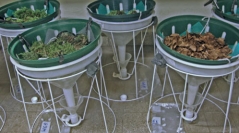

 Zoosystema
37 (1) - Pages 9-30
Zoosystema
37 (1) - Pages 9-30We present here the objectives, organization and preliminary results of the invertebrate inventory of the Mercantour National Park (“Terrestrial Invertebrates Module” of the ATBI Mercantour/Alpi Marittime), carried out by 68 scientists and field-collectors from 2009 to 2012. The conceptual framework of an ATBI and the interactions between inventorying and frequently associated research aims are discussed. The sampling strategy adopted combined standardized multi-taxon sampling (continuous and occasional) with individual taxon-centred sampling. The successive tasks of field sampling, specimen coding, sorting and identification, molecular analysis and data management are briefly described. A coherent system of sample coding ensured the traceability of specimens. The project results in terms of sampling effort, abundance of collected invertebrate fauna and biological diversity are presented globally, by techniques, by sites and by higher taxonomic groups: 259,412 specimens were obtained from 761 sorted samples (out of 1243 samples collected), belonging to 1725 identified species and subspecies, in addition to which 37 species new to science have been recognized. These data are progressively being integrated into the CardObs database of the INPN and are partly accessible through the EDIT and GBIF websites. Molecular analyses (barcoding) have provided 2800 sequences (mostly for the COI gene in Gastropoda, Collembola and Hymenoptera). Analysis of these sequences indicates a significant amount of cryptic diversity in the material. From a macro-ecological perspective, endemicity in the park decreases globally from south to north and species richness decreases at higher elevations, but the data are uneven and patterns vary according to group. Based on this four-year experience, it appears that a smaller survey area with lower habitat diversity would be better suited to the aims of an ATBI when the available resources are limited, and would enhance the efficiency of collective work in the field.
Biodiversity, field-sampling, labelling, sampling strategy, sampling techniques, southern Alps, specimen traceability.